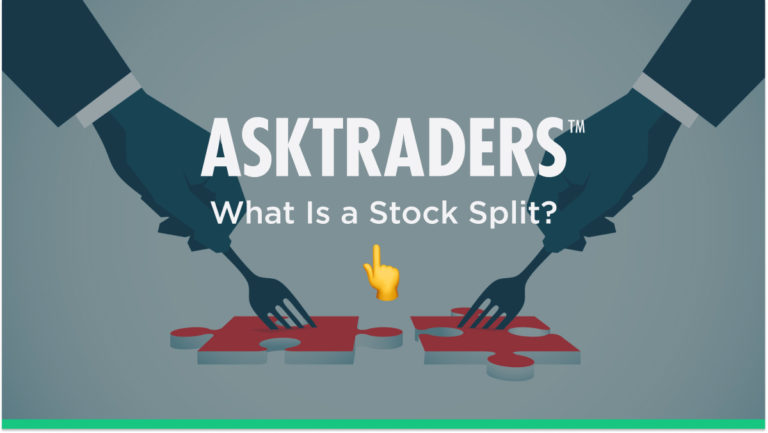
The behind-the-scenes work of reorganising the amount of stock investors hold is carried out by the company and its agents. Shareholders don’t have to take any action regarding the management of their portfolio, the update will be managed by their broker. In terms of the bottom line, it’s also important to note that the net total value of a shareholding will remain unchanged.
It is also important for investors to interpret the signals given off to the market when a stock split takes place. It can also help develop a better understanding of whether the announcement could be a signal to buy into a company.
The Stock Split Process
The most common stock splits use a 2-for-1 or 3-for-1 ratio, which are often referred to as 2:1 or 3:1.
The core part of the process involves the firm increasing the number of shares in circulation by the stated ratio. If, prior to a 2:1 stock split, the company has 3,000,000 shares in circulation, then after the process, there will be 6,000,00 shares available to buy in the market.
The additional 3,000,000 shares will be distributed to existing shareholders. An investor with a position of 250 shares will see an adjustment made automatically to their brokerage account and a position of 500 shares reported.
As the underlying valuation of a firm doesn’t change during a stock split, this doesn’t mean the investor who now has 500 shares doubles their money overnight. Instead, in the case of a 2:1 stock split, the market price of the shares will halve at the same time. If the split is 3:1 or 5:1, the share price will be divided by 3, or 5.
Certain protocols are in place and need to be followed to ensure transparency and that all investors are treated equally. As a result, there are some technical terms used to signpost the route through the process.
- Announcement Date: This is when the firm first declares that a stock split will take place and the pertinent details are revealed – the split ratio and timetable of the process will be clearly laid out.
- Record Date: The day when the company registrar will take a snapshot of all the share positions held by investors. This is the date when the investor in the above example is reported to be holding 250 shares of the company.
- Effective Date: The new shares won’t be credited to your account until the ‘effective date’. That date will be pre-advised in the original T&Cs and is the day in our example whereby our investor’s position will be reported as 500, not 250 shares.

Stock Split Example – A Historical View
Apple Inc has processed five stock splits since it was first publicly listed on the NASDAQ index in 1980.
The first Apple Inc (AAPL) stock split occurred on 16th June 1987 and was 2:1. As outlined, the market capitalisation of the firm remained unchanged on the effective date, but all investors received an additional share for each one they already owned. The price of AAPL stock halved overnight.
Subsequent stock splits included a 7:1 event in 2014 and a 4:1 split in 2020. The larger ratio of these splits reflected the extent to which AAPL stock had seen its price rise and the number of new shares required to bring it back to lower price levels.
As of September 2022, Apple stock was trading in the region of $150 per share, but if it hadn’t engaged in any stock splits, the firm’s stock would be priced closer to $1,800 per share. This introduces one of the reasons why firms carry out stock splits.
Advantages of Stock Splits
A lower share price can make it easier for investors to buy into a firm. Buying 12 shares of Apple stock at $150 per share can, for some, appear less daunting than buying one share valued at $1,800. Though the total cash consideration involved is the same, it breaks down an unnecessary potential barrier to entry. It also allows for a greater number of variables. Perhaps the investor would ideally like to invest $2,550. That is possible if they can buy 17 shares in the scenario where the stock price is lower.
It is also worth considering the potentially large pool of investors with $500 and $1,000 available to invest in Apple. These traders need the share price to be lower in order to execute that trade.
The increased market liquidity, which comes from there being more shares, can also make trading in the stock more cost-effective. Bid offer spreads narrow as liquidity increases and that reduces the costs associated with entering a position. That’s good news for retail investors but also for the companies themselves if they are engaging in a share buy-back scheme.
There are also reasons to consider the public message a firm is sending out to the markets when it announces a stock split. In this scenario, there is an underlying suggestion that the management is confident in the near- and medium-term prospects of the company. A stock split that was followed by a slide in the price of the stock could cause some embarrassment. Many would question the rationale behind the expense of processing a costly corporate action when the price corrected itself organically.
There is also a degree of ‘prestige’ associated with stock splits. It’s a relatively exclusive club and marks a firm out as being one that investors ought to consider.
Disadvantages of Stock Splits
The process of a stock split is expensive, takes up management time and requires legal oversight. It must be performed in accordance with guidelines stipulated by the exchange and regulatory laws. Stock splits don’t impact the fundamental position of a company, and therefore, despite the costs incurred, the process will do nothing in terms of creating additional value.
Another reason for firms to be wary of stock splits is that public exchanges such as the NASDAQ and NYSE require stock to trade at or above a certain level. In the case of the NASDAQ exchange, the minimum price a share can trade at is $1. If a firm’s share price drops below $1 for 30 consecutive days, the company is issued with a compliance warning. If the firm doesn’t rectify the situation within 180 days, the company risks being expelled from the exchange.
For example, the recent decision taken by Tesla in August 2022 to implement a 3-for-1 stock split rather than a 4-for-1 or 5-for-1, shows how firms don’t want to operate too close to the $1 per share limit set by the NASDAQ.
There is also an argument that a lower stock price can attract the wrong kind of investor. Day traders and short-sellers who run short-term speculative strategies can increase the amount of volatility in a stock. Their interests aren’t aligned with those of long-term investors and the company’s management, who could be left explaining why their stock price is fluctuating wildly.
One stock that has increased in value over time and has not undergone stock splits is that of Warren Buffet’s investment vehicle Berkshire Hathaway Inc (NYSE:BRK). The class A BRK shares currently have a share price of $442,149. To buy just one share in that company requires investors to find close to half a million dollars. The high entry bar hasn’t done much to dampen share price growth and has allowed the management team to avoid the costs of implementing corporate actions and instead focus on generating returns for investors.

What is a Reverse Stock Split?
A reverse stock split is simply the same kind of corporate action but in the opposite direction. A company carrying out a reverse stock split reduces the number of its outstanding shares and that increases the share price proportionately. As the mechanics of a stock split and reverse stock split are similar in nature, the market capitalisation of a company putting through a reverse stock split will, again, remain unchanged.
For example, if you own 10 shares of a stock in a company that announces a 2-for-1 reverse stock split, you’ll end up with five shares of stock. The price will double, so if those shares were valued at $2 per share before the reverse split, they’d be valued at $4 per share after the reverse split.
The main benefit of a reverse stock split is that it can avoid a firm being removed from an exchange for breaching minimum share price conditions. By keeping the stock publicly accessible, the management ensures more investors are able to buy the stock.
While the value of a holding doesn’t change during a reverse stock split, they are often considered to be a ‘red flag’ for investors. In the long run, it can help a company survive, restructure and recover, but in the short term, it’s a signal that a firm is in trouble.
Alternatively, some brokers have identified a gap in the market through the introduction of ‘fractional share dealing’. This allows clients to buy part of a share – if you’re buying Berkshire Hathaway stock, you simply enter the cash value of the transaction you want to complete and click ‘buy’. The broker will then combine the orders of its clients to go into the market to buy the required stock.
Unsurprisingly, fractional investing is becoming increasingly popular and it’s easy to speculate that stock splits will become less important.
Final Thoughts
While a stock split doesn’t change the material value of an investor’s holding, it can still have an impact on the share price of a firm. Stock splits signify that a company’s management is outperforming. They also allow more investors to buy into the company’s success story.
Whether you’re a seasoned investor or a new entrant to the market, it’s important to make sure your broker has experience in processing corporate actions. Choosing one from this list of brokers who support fractional trading is also worth considering. They have been reviewed by the AskTraders team to ensure they offer investors just what is needed to step into the market and become a successful trader.
